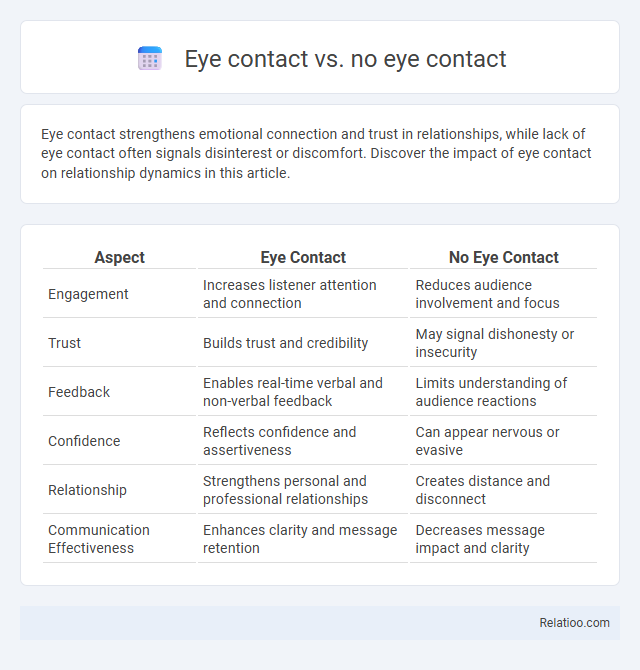Eye contact strengthens emotional connection and trust in relationships, while lack of eye contact often signals disinterest or discomfort. Discover the impact of eye contact on relationship dynamics in this article.
Table of Comparison
| Aspect | Eye Contact | No Eye Contact |
|---|---|---|
| Engagement | Increases listener attention and connection | Reduces audience involvement and focus |
| Trust | Builds trust and credibility | May signal dishonesty or insecurity |
| Feedback | Enables real-time verbal and non-verbal feedback | Limits understanding of audience reactions |
| Confidence | Reflects confidence and assertiveness | Can appear nervous or evasive |
| Relationship | Strengthens personal and professional relationships | Creates distance and disconnect |
| Communication Effectiveness | Enhances clarity and message retention | Decreases message impact and clarity |
Understanding the Power of Eye Contact
Eye contact plays a crucial role in communication, conveying confidence, trustworthiness, and attentiveness, while lack of eye contact can signal discomfort, disinterest, or evasiveness. Maintaining steady eye contact helps establish a strong connection, fostering deeper understanding and engagement during conversations. Your ability to balance eye contact appropriately enhances interpersonal interactions and strengthens social bonds.
Psychological Effects of Eye Contact
Eye contact enhances feelings of trust, confidence, and emotional connection by activating the social brain network, including the amygdala and prefrontal cortex. Lack of eye contact can trigger discomfort, social anxiety, and perceived evasiveness, leading to weaker interpersonal bonds. Maintaining balanced eye contact signals attentiveness and sincerity, fostering positive psychological effects such as increased empathy and improved communication outcomes.
Social Contexts: When to Use Eye Contact
Maintaining eye contact in social contexts signals confidence, trustworthiness, and engagement, especially during introductions, negotiations, or interviews. Avoiding eye contact can indicate discomfort, disinterest, or cultural respect, often appropriate in hierarchical or formal settings where deference is expected. Focusing eye contact selectively, such as steering gaze during conversations to balance attention and avoid intimidation, optimizes communication effectiveness and fosters positive social interactions.
The Impact of No Eye Contact in Communication
No eye contact in communication often leads to misunderstandings, reduced trust, and diminished engagement between speakers and listeners. Studies reveal that avoiding eye contact can signal disinterest, dishonesty, or insecurity, negatively impacting interpersonal relationships and workplace interactions. Maintaining appropriate eye contact enhances connection and clarity, while the absence of it creates barriers to effective communication.
Cultural Differences in Eye Contact Norms
Eye contact norms vary significantly across cultures, influencing social interactions and communication. In Western cultures, direct eye contact is often interpreted as confidence and sincerity, while many Asian cultures view prolonged eye contact as disrespectful or confrontational. Understanding these cultural differences is essential for effective cross-cultural communication, as misinterpreting eye contact cues can lead to misunderstandings and discomfort.
Eye Contact and Building Trust
Maintaining consistent eye contact plays a crucial role in building trust by signaling confidence, honesty, and attentiveness during interactions. Your ability to hold eye contact fosters a genuine connection, encouraging openness and mutual respect. Avoiding eye contact can create feelings of distrust or disinterest, while balanced eye contact reinforces positive communication and relationship-building.
Anxiety and Avoidance: Why People Shy Away from Eye Contact
Eye contact triggers the amygdala, often increasing anxiety and activating avoidance behaviors in socially anxious individuals. Those who avoid eye contact may experience temporary relief from discomfort but reinforce social withdrawal and fear responses over time. Maintaining moderate eye contact can help recalibrate the brain's threat perception, reducing avoidance tendencies and promoting social connection.
Eye Contact in Professional Settings
Maintaining consistent eye contact during professional interactions enhances trust, demonstrates confidence, and fosters clear communication, making it a crucial skill in business environments. Avoiding eye contact may be perceived as disinterest or nervousness, while excessive staring can create discomfort, so balance is key for effective engagement. Your ability to use appropriate eye contact can significantly influence professional relationships and outcomes in meetings, interviews, and presentations.
Nonverbal Cues: Balancing Eye Contact and No Eye Contact
Eye contact serves as a powerful nonverbal cue, signaling confidence, attention, and trustworthiness, while lack of eye contact can indicate discomfort, disinterest, or deceit. Balancing eye contact with natural breaks prevents staring, fostering a comfortable and genuine interaction that enhances communication effectiveness. Strategic use of eye contact modulates social dynamics, supporting empathy and engagement in professional and personal contexts.
Tips for Mastering Effective Eye Contact
Maintaining effective eye contact during communication establishes trust, shows attentiveness, and enhances message clarity, whereas avoiding eye contact can imply disinterest or evasiveness, undermining your credibility. Master the balance by holding gaze for 3 to 5 seconds, then briefly looking away to avoid staring, while focusing your eyes to convey confidence and sincerity. Your awareness of cultural norms and situational context helps tailor eye contact for optimal engagement and rapport building.

Infographic: Eye contact vs No eye contact
 relatioo.com
relatioo.com